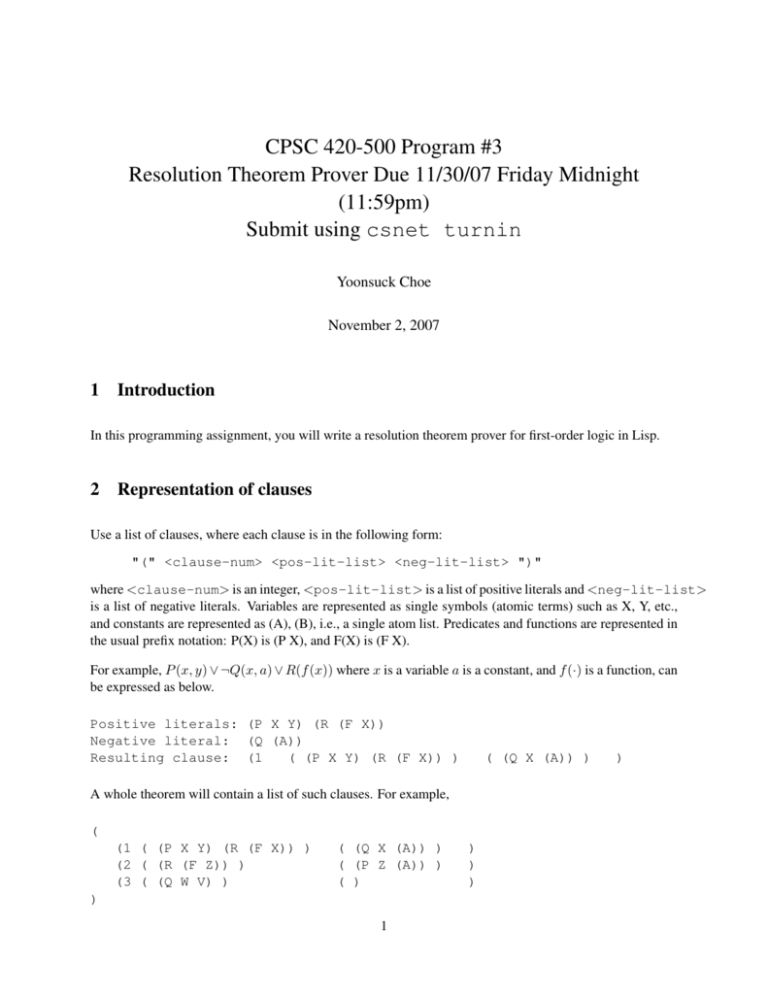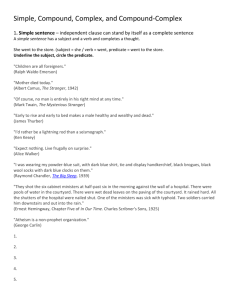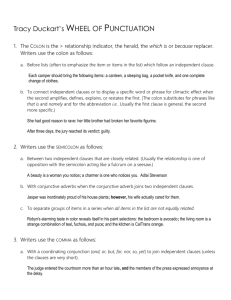CPSC 420-500 Program #3 Resolution Theorem Prover Due 11/30
advertisement

CPSC 420-500 Program #3 Resolution Theorem Prover Due 11/30/07 Friday Midnight (11:59pm) Submit using csnet turnin Yoonsuck Choe November 2, 2007 1 Introduction In this programming assignment, you will write a resolution theorem prover for first-order logic in Lisp. 2 Representation of clauses Use a list of clauses, where each clause is in the following form: "(" <clause-num> <pos-lit-list> <neg-lit-list> ")" where <clause-num> is an integer, <pos-lit-list> is a list of positive literals and <neg-lit-list> is a list of negative literals. Variables are represented as single symbols (atomic terms) such as X, Y, etc., and constants are represented as (A), (B), i.e., a single atom list. Predicates and functions are represented in the usual prefix notation: P(X) is (P X), and F(X) is (F X). For example, P (x, y) ∨ ¬Q(x, a) ∨ R(f (x)) where x is a variable a is a constant, and f (·) is a function, can be expressed as below. Positive literals: (P X Y) (R (F X)) Negative literal: (Q (A)) Resulting clause: (1 ( (P X Y) (R (F X)) ) ( (Q X (A)) ) A whole theorem will contain a list of such clauses. For example, ( (1 ( (P X Y) (R (F X)) ) (2 ( (R (F Z)) ) (3 ( (Q W V) ) ( (Q X (A)) ) ( (P Z (A)) ) ( ) ) 1 ) ) ) ) Note that if the given clause only contains positive or negative literals but not both, the empty one should be represented as ( ), such as in clause 3 above (which would be simply Q(w, v)). Initially, the list will contain the premise clauses, followed by clauses derived from the negated conclusion. As resolvents are generated from these clauses, they are added to the end of the list. For simplicity, you may assume that the sets of symbols used as predicate names, function names, and variable names are unique in any given problem (as in the example above), i.e. you can do all the necessary pre-processing by hand before feeding in the problem to the prover. For example, clauses 1, 2, and 3 above do not have any shared variable. However, as you go along with resolution, you may have to check if the two clauses drawn from the set of clauses have overlapping variables. To check this, you may have to extract all the arguments of the literals. For this, use mapcan, which applies a function on each element of a given list and concatenates the result. There are other map.. functions that may be of interest to you as well, such as mapcar. * (mapcan #’cdr ’((p x y) (r (f x)))) (X Y (F X)) * (mapcar #’cdr ’((p x y) (r (f x)))) ((X Y) ((F X))) Basically what you are doing above is (cdr ’(p x y)) which gives you (x y) and (cdr ’(r (f x))) which gives you ((f x)), which is then appended (for mapcan). See the next section for some more details on renaming variables to avoid confusion. 3 Coding the Resolution Algorithm 3.1 General instructions Here are some general instructions you should follow: 1. Print out each input clause and each clause that is produced by resolution; number the printed clauses and show the numbers of the clauses from which they are derived. Remember that more than one resolution of a given pair of clauses may be possible. However, we will not worry about resolving on factors of clauses. 2. A unification algorithm is provided in the file sunify.lsp. The clauses must first be rewritten so that they have no variables in common in case there are repeated variables across two clauses. To avoid any confusion, simply replace every variable in a clause with a new symbol (do it consistently so that the same variable is replaced with the same new symbol) before you unify/resolve. For example, * (load "sunify.lsp") ; Loading #p"/user/choe/sunify.lsp". T * (unify ’(p x) ’(p (a))) 2 ((X A)) * (unify ’(p x (f x)) ’(p (g x) (f (a)))) NIL * (unify ’(p x (f x)) ’(p (g y) (f (g (a))))) ((Y A) (X G (A))) * If you need to generate new symbols, use (intern (symbol-name (gensym))). Try running this several times and see what kind of symbol you get. For example, if you have (1 ((P X)) ((Q X (A))) ) and you want to replace x with a unique new variable, you can do something as follows, using the the (subst <replace-pattern> <pattern> <expression>) function. Note that G1303 is the newly created symbol. * (subst (intern (symbol-name (gensym))) ’x ’(1 ((P X)) ((Q X (A))))) (1 ((P G1303)) ((Q G1303 (A)))) * 3.2 Resolution algorithm Use the two-pointer method to select pairs of clauses for resolution; initialize the pointers so that you will be using the set-of-support strategy. This can be done in the following way: 1. Initialize: Set the “inner loop” pointer to the front of the list of clauses. Set the “outer loop” pointer to the first clause resulting from the negated conclusion. 2. Resolve: If the clauses denoted by the two pointers can be resolved, produce the resolvent (you may have to go through the positive and negative literal lists in the two clauses looking for a single complementary literal). Add the resolvent to the end of the list of clauses and print it out. (Note: There may be more than one possible resolvent from a pair of clauses. In that case, generate multiple resolvants based on all possible resolvable pairs. See below. Also, if you generated a clause that is already in the list of clauses, do not add it.) If the resolvent is empty (False), stop; the theorem is proved. 3. Step: Move the “inner loop” pointer forward one clause. If the “inner loop” pointer has not reached the “outer loop” pointer, go to the Resolve step. Otherwise, reset the “inner loop” pointer to the front of the list of clauses and move the “outer loop” pointer forward one clause. If the “outer loop” pointer goes beyond the last clause in the list, stop; the theorem cannot be proved (no more clauses are left that are resolvable). The “two-pointer method” is a breadth-first method that will generate many duplicate clauses. When resolving two clauses, for simplicity, we will not find the factor. Instead, for all possible resolvents, generate a list of resulting clauses. For example, suppose you have to resolve the two clauses below. 3 ( 1 ( (P X) (P (A)) ) ( 2 ( ) ( (Q X) ) ) ; clause 1 ( (P (A)) ) ) ; clause 2 In this case, in the first clause, there are two (P ·)s, so, what you do is produce two clauses, by first unifying (P X) and (P (A)) to get ( 3 ( (P (A) ) ( (Q (A)) ) ) ; clause 3 and next, resolving (P (A)) and (P (A)) to get the following. ( 4 ( (P X) ) ( (Q X) ) ) ; clause 4 So, you will get two clauses (clauses 3 and 5) by resolving the clauses clause 1 and 2. For duplicate checks, simply use the (dupe ...) function in dupeclause.l in the src/ directory. This is a really simplistic, literal duplicate checker, so it will say certain clauses are not duplicates when they really are (logically), but that’s fine. For example, try this: * (dupe ’(1 ((q x) (p y)) ()) ’(2 ((p y) (q x)) ())) T * (dupe ’(1 ((q x) (p y)) ()) ’(2 ((p y) (q (a))) ())) NIL * (dupe ’(1 ((q x) (p y)) ()) ’(2 ((p y) (q z)) ())) NIL 3.3 Linear Resolution Implement linear resolution, and compare the performance in: • the number of resolution steps taken to derive False, and/or • if it ever reaches the answer or not. 3.4 Unit preference Implement unit preference, and compare the performance in: • the number of resolution steps taken to derive False, and/or • if it ever reaches the answer or not. 4 4 Submission Instruction 4.1 Testing your prover Run your provers on these three problems and summarize the results (see the file theorems.lsp): 1. Howling hound, 2. Drug dealer and customs official, and 3. Coyote and roadrunner. Do all of these reduce to False? In addition to the above: 4. Convert the Harmonia example in slide04.pdf, page 133, into a resolution problem format in Lisp, and run the prover. Once you have derived False, manually examine the resolution steps printed out by your prover and find out at which point the question could have been answered (who is a grandparent of Harmonia?). You don’t need to write a program to do this – simply report your analysis. 4.2 Submitting Name and run your prover like this: • (two-pointer *problem* 6) • (linear *problem* 6) • (unit-preference *problem*) where *problem* is a global variable pointing to the list of clauses (e.g. *howl-hound*), and 6 is the first clause of the negated conclusion (assume that the clause number begins with 1). Submit the code prover.lsp, README using the csnet turnin page. The README file should contain the following: 1. The Harmonia theorem represented in Lisp. 2. Test results of two-pointer and unit-preference on the four theorems (howling hound, customs official, roadrunner, and Harmonia). • Draw a table where the rows are the theorems and the columns are the three theorem proving methods. Thus, you’ll get 8 results in all. • In each cell, enter the number of resolution steps taken to derive False. 5 • If it takes too long, stop it after say 10 minutes and indicate that in the table, and report why you think it failed. • If it completes without deriving False, indicate so and explain what that means. 3. Explain what you think are the differences in the resulting resolution steps between the three different theorem proving methods. 4. Print out the full resolution steps in each case. The grading criteria are as follows: 1. README: 20% 2. Program: 80% (two-pointer: 40%; linear resolution: 20%; unit-preference: 20%) Appendix The coyote and roadrunner theorem is as follows: 1. Every coyote chases some roadrunner. 2. Every roadrunner who says “beep-beep” is smart. 3. No coyote catches any smart roadrunner. 4. Any coyote who chases some roadrunner but does not catch it is frustrated. 5. (Conclusion) If all roadrunners say “beep-beep”, then all coyotes are frustrated. More examples at http://www.cs.utexas.edu/users/novak/resosol.html. All theorems in this assignment are originally by Gordon Novak (see the above url). All program files and theorem files are located in http://courses.cs.tamu.edu/choe/07fall/src/. 6









